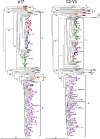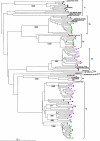Molecular characterization of human immunodeficiency virus type 1 and hepatitis C virus in paid blood donors and injection drug users in china
- PMID: 15564470
- PMCID: PMC533913
- DOI: 10.1128/JVI.78.24.13591-13599.2004
Molecular characterization of human immunodeficiency virus type 1 and hepatitis C virus in paid blood donors and injection drug users in china
Abstract
China is facing a rapid upsurge in cases of human immunodeficiency virus type 1 (HIV-1) and hepatitis C virus (HCV) infection due to large numbers of paid blood donors (PBD), injection drug users (IDU), and sexual partners of infected individuals. In this report, a total of 236 HIV-1-positive blood samples were collected from PBD, IDU, and their sexual partners in the most severely affected provinces, such as Henan, Yunnan, Guangxi, and Xinjiang. PCR was used to amplify the p17 region of gag and the C2-V3 region of env of HIV-1 and the 5' noncoding region and a region of E1/E2 of HCV. Genetic characterization of viral sequences indicated that there are two major epidemics of HIV-1 and multiple HCV epidemics in China. The PBD and transfusion recipients in Henan harbored HIV-1 subtype B', which is similar to the virus found in Thailand, and HCV genotypes 1b and 2a, whereas the IDU in Yunnan, Guangxi, and Xinjiang carried HIV-1 circulating recombinant forms 07 and 08, which resemble those in India, and HCV genotypes 1b, 3a, and 3b. Our findings show that the epidemics of HIV-1 and HCV infection in China are the consequences of multiple introductions. The distinct distribution patterns of both the HIV-1 and HCV genotypes in the different high-risk groups are tightly linked to the mode of transmission rather than geographic proximity. These findings provide information relevant to antiviral therapy and vaccine development in China and should assist public health workers in implementing measures to reduce the further dissemination of these viruses in the world's most populous nation.
Figures



References
-
- Anonymous. AIDs prevention in China. China MOH News. November 27, 2002. http://www.moh.gov.cn/public/open.aspx?n_id=3473. (In Chinese.)
-
- Anonymous. 2001. China UN theme group on HIV/AIDS for the UN country team in China, HIV/AIDS: China's titanic peril (2001 update of the AIDS situation and needs assessment report, UNAIDS, Beijing), p. 1-160 UNAIDS, Geneva, Switzerland.
-
- Anonymous. 2002. UN epidemiological fact sheets on HIV/AIDS and sexually transmitted infections, p. 1-92. UNAIDS, Geneva, Switzerland.
-
- Beach, M. V. 2001. “Blood heads” and AIDS haunt China's countryside. Lancet 357:49. - PubMed
MeSH terms
Associated data
- Actions
- Actions
- Actions
- Actions
- Actions
- Actions
- Actions
- Actions
- Actions
- Actions
- Actions
- Actions
- Actions
- Actions
- Actions
- Actions
- Actions
- Actions
- Actions
- Actions
- Actions
- Actions
- Actions
- Actions
- Actions
- Actions
- Actions
- Actions
- Actions
- Actions
- Actions
- Actions
- Actions
- Actions
- Actions
- Actions
- Actions
- Actions
- Actions
- Actions
- Actions
- Actions
- Actions
- Actions
- Actions
- Actions
- Actions
- Actions
- Actions
- Actions
- Actions
- Actions
- Actions
- Actions
- Actions
- Actions
- Actions
- Actions
- Actions
- Actions
- Actions
- Actions
- Actions
- Actions
- Actions
- Actions
- Actions
- Actions
- Actions
- Actions
- Actions
- Actions
- Actions
- Actions
- Actions
- Actions
- Actions
- Actions
- Actions
- Actions
- Actions
- Actions
- Actions
- Actions
- Actions
- Actions
- Actions
- Actions
- Actions
- Actions
- Actions
- Actions
- Actions
- Actions
- Actions
- Actions
- Actions
- Actions
- Actions
- Actions
- Actions
- Actions
- Actions
- Actions
- Actions
- Actions
- Actions
- Actions
- Actions
- Actions
- Actions
- Actions
- Actions
- Actions
- Actions
- Actions
- Actions
- Actions
- Actions
- Actions
- Actions
- Actions
- Actions
- Actions
- Actions
- Actions
- Actions
- Actions
- Actions
- Actions
- Actions
- Actions
- Actions
- Actions
- Actions
- Actions
- Actions
- Actions
- Actions
- Actions
- Actions
- Actions
- Actions
- Actions
- Actions
- Actions
- Actions
- Actions
- Actions
- Actions
- Actions
- Actions
- Actions
- Actions
- Actions
- Actions
- Actions
- Actions
- Actions
- Actions
- Actions
- Actions
- Actions
- Actions
- Actions
- Actions
- Actions
- Actions
- Actions
- Actions
- Actions
- Actions
- Actions
- Actions
- Actions
- Actions
- Actions
- Actions
- Actions
- Actions
- Actions
- Actions
- Actions
- Actions
- Actions
- Actions
- Actions
- Actions
- Actions
- Actions
- Actions
- Actions
- Actions
- Actions
- Actions
- Actions
- Actions
- Actions
- Actions
- Actions
- Actions
- Actions
- Actions
- Actions
- Actions
- Actions
- Actions
- Actions
- Actions
- Actions
- Actions
- Actions
- Actions
- Actions
- Actions
- Actions
- Actions
- Actions
- Actions
- Actions
- Actions
- Actions
- Actions
- Actions
- Actions
- Actions
- Actions
- Actions
- Actions
- Actions
- Actions
- Actions
- Actions
- Actions
- Actions
- Actions
- Actions
- Actions
- Actions
- Actions
- Actions
- Actions
- Actions
- Actions
- Actions
- Actions
- Actions
- Actions
- Actions
- Actions
- Actions
- Actions
- Actions
- Actions
- Actions
- Actions
- Actions
- Actions
- Actions
- Actions
- Actions
- Actions
- Actions
- Actions
- Actions
- Actions
- Actions
- Actions
- Actions
- Actions
LinkOut - more resources
Full Text Sources
Medical
Molecular Biology Databases
Miscellaneous

